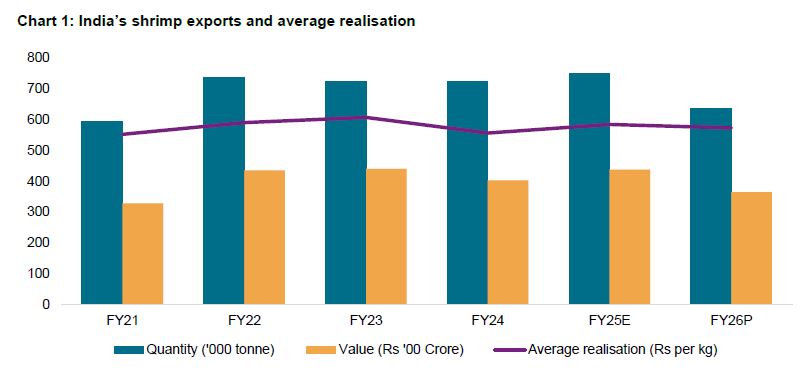Blog

Mumbai: India’s shrimp export volume is expected to fall by 15–18% in the current fiscal year following a sharp increase in tariffs imposed by the United States, according to a report released by Crisil Ratings. The new tariff rate of 58.26%, which includes countervailing and anti-dumping duties, came into effect on August 27, 2025, and has rendered exports to the US market economically unviable for most Indian processors.
The US accounted for nearly 48% of India’s $5 billion shrimp exports in fiscal 2025, making it the largest destination for Indian seafood. Crisil Ratings noted that while exporters had anticipated the tariff hike and front-loaded shipments in the first quarter, overall revenues are still projected to decline by 18–20% year-on-year. The inability to pass on the increased costs to buyers has led to a projected erosion of operating profit margins by 150–200 basis points, pushing margins to a decade-low of 5.0–5.5%.
Rahul Guha, senior director, Crisil Ratings, said the tariff shock would have cascading effects across the value chain as the headwinds will impact processors and discourage farmers from continuing to invest in shrimp culture. “Farmers incur upfront costs for land lease, seed and feed. Additionally, investments in equipment for aeration, electricity and overall pond management and biosecurity have substantially raised the production cost. To boot, the risk of diseases, reduced harvests and unprofitable global prices have been forcing farmers to look at alternative cultures that entail lower investments and limited risks,” he said.
The report highlights that India’s competitive position has weakened significantly compared to other major shrimp-exporting countries such as Ecuador, Vietnam, Indonesia and Thailand, which face substantially lower tariffs in the US market. Despite India’s well-developed domestic infrastructure and strong distribution networks in the US, the steep tariff hike has tilted the playing field.
Crisil Ratings analysed 63 shrimp exporters, representing approximately 55% of industry revenues, and found that their credit profiles are likely to deteriorate. Interest coverage ratios are expected to moderate to around 3.3 times this fiscal from 4.8 times last year, reflecting the pressure on profitability. Himank Sharma, director, Crisil Ratings, noted that the credit profiles of shrimp exporters focused on the US market will face further challenges after two sluggish years.
The decline in export volume is also expected to reduce capacity utilisation and shrink sales of value-added and large-sized shrimp, which were primarily destined for the US and commanded higher margins. While working capital debt may ease due to lower business volumes, the overall debt protection metrics are set to weaken.
Indian shrimp processors are understood to be exploring alternative markets such as the United Kingdom – aided by the India–UK free trade agreement – as well as China and Russia. These efforts may provide partial relief in the second half of the fiscal year, but are unlikely to fully offset the loss of US-bound shipments.
Responding to the mounting trade challenges, the Indian government has launched a strategic initiative to bolster the domestic shrimp market. A dedicated committee has reportedly been formed under the National Fisheries Development Board (NFDB) to chart a roadmap for building a resilient local ecosystem for shrimp consumption. This multi-stakeholder body comprises representatives from farming communities, feed manufacturers, and the Marine Product Export Development Authority (MPEDA), which plays a key role in export market development.
As part of this initiative, efforts are underway to raise public awareness about the nutritional benefits of shrimp. Proposals include setting up promotional stalls across key urban centres to educate consumers and encourage greater uptake. With India’s per capita shrimp consumption currently lagging behind countries like Japan, there is considerable scope to expand domestic demand.
To bridge this gap and cushion the impact of recent export disruptions, shrimp producers have proposed a range of innovative solutions. These include pioneering methods for transporting live shrimp without water and establishing interactive experience centres to engage and inform consumers.
Developing a strong domestic market is increasingly seen as essential for ensuring fair returns to producers and reducing dependence on unpredictable global trade dynamics. Expanding internal demand would also give Indian consumers access to premium-quality shrimp, much of which has traditionally been reserved for export.
The long-term viability of shrimp farming will depend not only on diversifying export destinations but also on significantly boosting domestic consumption. With the sector at a critical juncture, both processors and farmers must adapt to a more uncertain global trade environment while tapping into the untapped potential of the Indian consumer base.
(Write to us at editorial@bombaychamber.com)








